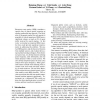954 search results - page 127 / 191 » Learning and prediction of slip from visual information |
JUCS
2006
13 years 7 months ago
2006
We outline the Berlin Brain-Computer Interface (BBCI), a system which enables us to translate brain signals from movements or movement intentions into control commands. The main co...
CVPR
2007
IEEE
14 years 9 months ago
2007
IEEE
We propose a method for learning using a set of feature representations which retrieve different amounts of information at different costs. The goal is to create a more efficient ...
MM
2009
ACM
14 years 2 months ago
2009
ACM
We propose a novel technique for semi-supervised image annotation which introduces a harmonic regularizer based on the graph Laplacian of the data into the probabilistic semantic ...
EMNLP
2010
13 years 5 months ago
2010
Recurrent event queries (REQ) constitute a special class of search queries occurring at regular, predictable time intervals. The freshness of documents ranked for such queries is ...
CIBCB
2005
IEEE
14 years 1 months ago
2005
IEEE
— Part of the challenge of modeling protein sequences is their discrete nature. Many of the most powerful statistical and learning techniques are applicable to points in a Euclid...

